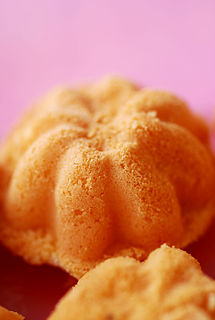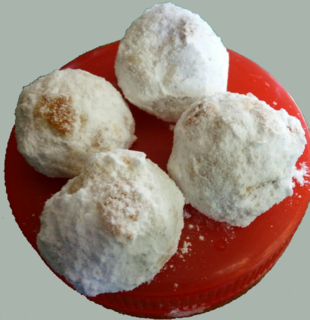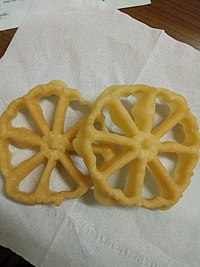
Malay cuisine is the traditional food of the ethnic Malays of Southeast Asia, residing in modern-day Malaysia, Indonesia, Singapore, Brunei, Southern Thailand and the Philippines as well as Cocos Islands, Christmas Island, Sri Lanka and South Africa.

Kuih are bite-sized snack or dessert foods commonly found in Southeast Asia. It is a fairly broad term which may include items that would be called cakes, cookies, dumplings, pudding, biscuits, or pastries in English and are usually made from rice or glutinous rice. The term kuih is widely used in Malaysia, Brunei, and Singapore, and kueh or kue is used in Indonesia, to refer to sweet or savoury desserts. Though called by other names, one is likely to find various similar versions of kuih in neighbouring countries, such as Vietnam, Thailand, and Myanmar. For example, the colourful steamed kue lapis and the rich kuih bingka ubi are also available in Myanmar, Thailand, and Vietnam. In the Philippines, kuih are referred to in Tagalog as kakanin.

Kue kochi or koci is a Maritime Southeast Asian dumpling found in Javanese, Malay and Peranakan cuisine, made from glutinous rice flour, and stuffed with coconut fillings with palm sugar.

Rosette cookies are thin, cookie-like fritters made with iron molds that are found in many cultures. The name rosettbakkels comes from Norwegian. Rosettes are crispy and typified by their lacy pattern. Rosettes are traditionally made during Christmas time. Rosette recipes are popular in the United States among families with Scandinavian ancestry.

Kuih seri muka, sri muka or putri salat is a Banjarese and Malay two-layered dessert with steamed glutinous rice forming the bottom half and a green custard layer made with pandan juice. Coconut milk is a key ingredient in making this kue. It is used to impart creamy taste when cooking the glutinous rice and making the custard layer. This kue found in Indonesia, Malaysia and Singapore.

Nasi ulam is an traditional Indonesian dish of steamed rice (nasi) served with various herbs and vegetables (ulam)

Pie Tee is a thin and crispy pastry tart shell kuih often filled with a spicy, shredded Chinese turnips, sweet mixture of thinly sliced vegetables and prawns. It is a popular Peranakan dish. The shells are made of flour and though some stores will make them from scratch, they can usually be found ready made in most supermarkets. Similar to popiah, the main filling is shredded Chinese turnips and carrots, and usually these two dishes are sold by the same stall in hawker centres.

Clorot, celorot, cerorot, or jelurut is an Indonesian traditional sweet snack made of sweet and soft rice flour cake with coconut milk, wrapped with janur or young coconut leaf in cone shape. It is a popular traditional sweet snack commonly found in Brunei, Indonesia, and Malaysia.

Kue semprong, Asian egg roll, sapit, sepit, kue Belanda, or kapit, is an Indonesian traditional wafer snack made by clasping egg batter using an iron mold which is heated up on a charcoal stove. It is commonly found in Indonesia, Malaysia, Singapore and Brunei.

Wajik or wajid, also known as pulut manis, is a traditional glutinous sweet made with rice, sugar and coconut milk. It is an Indonesian kue, and a kuih of Brunei and Malaysia.

Bahulu or baulu is a traditional Malay pastry (kue/kuih). It is similar in concept to the madeleine cake, but round in shape and composed of different ingredients. There are three versions available, the most common being bahulu cermai (star-shaped) and the more elusive bahulu gulung and bahulu lapis (layered). Bahulu is believed to be originated in Malay Peninsula during the colonization era and is the corruption of the Malaccan Kristang word, bolu which means cake. It is usually served during Eid al-Fitr as well as during the Chinese New Year.

Kue cucur (Indonesian) or kuih cucur (Malay), known in Thai as khanom fak bua or khanom chuchun, is a traditional snack from Indonesia, and popular in parts of Southeast Asia, includes Indonesia, Malaysia, southern Thailand and Singapore. In Indonesia, kue cucur can be found throughout traditional marketplaces in the country; the popular version, however, is the Betawi version from Jakarta. In Brunei and Malaysia, the term cucur is generally used to refer to any type of fritters. A popular type of cucur in Brunei and Malaysia is Jemput-jemput and Pinjaram. In Southern Thailand, it is often featured in wedding ceremonies and festivals.

Betawi cuisine is rich, diverse and eclectic, in part because the Betawi people that create them were composed from numbers of regional immigrants that came from various places in the Indonesian archipelago, as well as Chinese, Indian, Arab, and European traders, visitors and immigrants that were attracted to the port city of Batavia since centuries ago.

Kue lapis is an Indonesian kue, or a traditional snack of steamed colourful layered soft rice flour pudding. In Indonesian lapis means "layers". This steamed layered sticky rice cake or pudding is quite popular in Indonesia, Suriname and can also be found in the Netherlands through their colonial links. Kue lapis is also very popular in neighbouring Malaysia, Singapore, and Brunei where it is called kuih lapis. Kue lapis was introduced by the Sino-Burmese to Lower Myanmar, where it is known as kway lapay (ကွေလာပေး) or kway lapaysa (ကွေလာပေးစ).

Achappam is a deep fried rose cookie made with rice flour. It is a signature Syrian Christian food believed to come from Dutch influence. In Kerala, it is an essential snack for Christians on special days such as Christmas and marriage ceremonies. It has since spread to South East Asia where it has various local names such as kuih loyang (brass), acuan (mould), cap (stamp), bunga ros, bunga durian, goyang (shake), kembang loyang, dok jok(water lettuce), etc.

Kue makmur is a traditional Malay kue or kuih. This cake made from butter, ghee and flour, and served during special occasion of Eid al-Fitr. Kue makmur is identified with its white colour and usually in a round shape.

Kue rangi or also called sagu rangi is an Indonesian coconut kue or traditional snack made of a coconut and starch-based batter and cooked in a special molded pan. It is one of the traditional Betawi snack of Jakarta. Kue rangi often described as Indonesian coconut waffle.

Kue pancong, kue pancung, bandros, gandos, or buroncong is an Indonesian kue or traditional snack made of a rice flour and coconut-based batter and cooked in a special mold pan. It is a commonly found snack in Indonesian traditional markets. Kue pancong is usually associated with Betawi cuisine of Jakarta, while bandros is often associated with Sundanese cuisine of Bandung city, and buroncong with Makassarese cuisine of Makassar, although all refer to the same coconut hot cake.

Kue talam is an Indonesian kue or traditional steamed snack made of a rice flour, coconut milk and other ingredients in a mold pan called talam which means "tray" in Indonesian. The cake mold used to create kue talam are either larger rectangular aluminium tray or smaller singular cups made from ceramics, aluminium, melamine or plastic.

Kue bangkit is a small biscuit that made from sago starch of Malay origin, commonly found in Indonesia and Malaysia. This biscuit has various colours, ranging from white, yellowish to brown, depends on the additional ingredients.





















